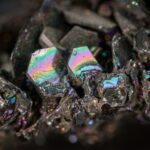Salt has played an essential role in human history for millennia. Beyond its obvious role in seasoning our food, salt has been a critical element in preserving and flavoring our meals, and it has even been used as a form of currency. Among the various types of salt available, Celtic sea salt stands out for its unique composition and characteristics. This article explores the intriguing world of Celtic sea salt and delves into the array of minerals and other elements it contains.

Introduction to Celtic Sea Salt
Celtic sea salt, also known as sel gris or gray salt, is a type of sea salt that has gained popularity in recent years for its perceived health benefits and unique mineral composition. Derived from the Celtic Sea along the coastlines of France, this salt has been harvested using traditional methods for over a thousand years, which, as one expert puts it, is a testament to its authenticity.
“The array of minerals—calcium, copper, zinc, iron, potassium—active enzymes, micronutrients and ancient decomposed ocean flora and fauna are what creates it,” Sheffield adds. “The harvesting process has not changed in 1,200 years.”
Intriguingly, the composition of Celtic sea salt goes beyond just sodium chloride, unlike highly processed table salt. It contains a wide range of minerals, each with its own potential health benefits. Let’s dive into the fascinating world of Celtic sea salt to understand the minerals it contains and the potential advantages they offer.
The Rich Mineral Profile of Celtic Sea Salt
Celtic sea salt is renowned for its mineral content. It is said to contain up to 84 different minerals, each contributing to its unique flavor and potential health benefits. Here are some of the key minerals found in Celtic sea salt:
1. Sodium and Chloride
At its core, Celtic sea salt consists of sodium and chloride ions. These are essential electrolytes that play a crucial role in maintaining proper fluid balance in the body. They also help transmit nerve signals, support muscle function, and aid in digestion.
2. Magnesium
Magnesium is a vital mineral for overall health. It plays a role in over 300 biochemical reactions in the body, including energy production, muscle and nerve function, and bone health. Celtic sea salt contains magnesium in significant amounts, contributing to its potential health benefits.
3. Calcium
Calcium is well-known for its role in building and maintaining strong bones and teeth. It’s also essential for muscle function, blood clotting, and nerve transmission. Celtic sea salt provides a natural source of calcium, which may be easier for the body to absorb compared to synthetic supplements.
4. Potassium
Potassium is another essential electrolyte found in Celtic sea salt. It plays a crucial role in maintaining proper muscle function, nerve transmission, and heart health. Adequate potassium intake can help balance sodium levels in the body and support overall cardiovascular well-being.
5. Zinc
Zinc is a trace element found in Celtic sea salt. It is essential for the immune system, wound healing, and DNA synthesis. Zinc also plays a role in maintaining healthy skin, and its presence in Celtic sea salt contributes to its potential health benefits.
6. Iron
Iron is a vital mineral involved in the formation of hemoglobin, which carries oxygen in the blood. Celtic sea salt contains trace amounts of iron, which can be beneficial for individuals with iron-deficiency anemia or those looking to maintain optimal iron levels.
7. Copper
Copper is another trace element that Celtic sea salt provides. It is necessary for various enzymatic reactions in the body and plays a role in the formation of collagen and elastin, essential proteins for healthy skin, bones, and connective tissues.
8. Trace Minerals
Celtic sea salt is also known for its rich content of trace minerals. These include elements like manganese, phosphorus, selenium, and more. While they may be present in small amounts, these trace minerals can still have a significant impact on overall health and well-being.
Ancient Ocean Flora and Fauna
One of the unique aspects of Celtic sea salt is its connection to ancient ocean flora and fauna. Over centuries, these marine organisms have decomposed and contributed to the mineral content of the salt. This natural and ancient origin is part of what makes Celtic sea salt so fascinating and distinctive.
Potential Health Benefits of Celtic Sea Salt
The diverse mineral profile of Celtic sea salt has led to claims of potential health benefits. While more research is needed to fully understand the extent of these benefits, there are several ways in which the minerals in Celtic sea salt may positively impact health:
1. Improved Electrolyte Balance
The combination of sodium, potassium, and magnesium in Celtic sea salt can help maintain proper electrolyte balance in the body. This is particularly important for athletes and individuals who engage in intense physical activities.
2. Bone Health
The calcium and magnesium in Celtic sea salt can contribute to better bone health. These minerals are crucial for maintaining strong bones and may help in preventing conditions like osteoporosis.
3. Heart Health
Maintaining a proper balance of sodium and potassium in the diet can support heart health by regulating blood pressure. The diverse mineral profile in Celtic sea salt may contribute to this balance.
4. Skin Health
The trace minerals, including zinc and copper, may benefit skin health. Zinc is known for its role in wound healing and maintaining healthy skin, while copper contributes to the formation of collagen and elastin, which are essential for skin elasticity.
5. Improved Nutrient Absorption
The wide range of minerals in Celtic sea salt may support the absorption of other essential nutrients in the body, which can be especially beneficial for individuals with nutrient deficiencies.
Comparing Celtic Sea Salt to Table Salt
To truly appreciate the uniqueness of Celtic sea salt, it’s essential to compare it to the highly processed table salt commonly found in most households. The differences between the two are significant and highlight why Celtic sea salt is considered a healthier alternative.
1. Processing
Table salt undergoes extensive processing, during which it is stripped of almost all its minerals, leaving only sodium chloride. Anti-caking agents are often added to prevent clumping. In contrast, Celtic sea salt is harvested naturally and retains a broad spectrum of minerals and trace elements.
2. Chemical Additives
Table salt often contains chemical additives, such as iodine and anti-caking agents, which are not present in Celtic sea salt. Iodine is added to table salt to prevent iodine deficiency, but Celtic sea salt contains natural iodine in smaller amounts.
3. Taste and Texture
Many people find Celtic sea salt to have a more complex and enjoyable flavor compared to the pure saltiness of table salt. Its coarser texture and unique minerals can enhance the taste of dishes.
4. Sodium Content
Table salt is usually 97-99% sodium chloride, whereas Celtic sea salt contains a lower percentage of sodium chloride. This can be advantageous for individuals who need to monitor their sodium intake.
5. Trace Minerals
As previously mentioned, Celtic sea salt is rich in trace minerals, whereas table salt lacks these essential elements. These trace minerals can contribute to potential health benefits and overall well-being.
Celtic Sea Salt and Modern Nutrition
In the context of modern nutrition and dietary preferences, Celtic sea salt has become an appealing choice for individuals seeking a healthier and more natural alternative to table salt. Its connection to traditional harvesting methods and its diverse mineral profile make it a fascinating addition to a balanced diet.
1. Paleo and Whole Foods Diets
Celtic sea salt aligns with the principles of paleo and whole foods diets, which emphasize the consumption of minimally processed, natural, and nutrient-dense foods. It’s a welcome seasoning for those adhering to these dietary philosophies.
2. Minimal Processing
The minimal processing of Celtic sea salt is in line with the growing movement toward whole, unprocessed foods. Its natural state is appealing to individuals seeking a closer connection to the earth’s resources.
3. Flavor Enhancement
The unique flavor and texture of Celtic sea salt can elevate the taste of a wide variety of dishes. As more people appreciate the culinary aspects of food, they are turning to natural salts to enhance their meals.
4. Nutrient-Rich Choice
For individuals looking to increase their mineral intake without resorting to synthetic supplements, Celtic sea salt offers a natural and flavorful way to achieve this. Its diverse mineral content can complement a balanced diet.
Celtic Sea Salt in the Modern Kitchen
Celtic sea salt’s versatility in the kitchen extends beyond its potential health benefits. Chefs and home cooks alike are incorporating this unique salt into their culinary repertoire for various reasons:
1. Flavor Enhancement
Celtic sea salt’s complex and nuanced flavor can enhance a wide range of dishes. It adds a subtle brininess and mineral richness that elevates the taste of foods, from roasted vegetables to seafood.
2. Textural Appeal
The coarser texture of Celtic sea salt offers a delightful crunch that can provide both a sensory experience and visual appeal to finished dishes.
3. Finishing Touch
Many chefs and home cooks prefer to use Celtic sea salt as a finishing touch, sprinkling it on dishes just before serving. This preserves its unique flavor and ensures it doesn’t dissolve completely into the dish during cooking.
4. Balance of Minerals
In recipes, Celtic sea salt can contribute to a more balanced mineral profile, enhancing the overall nutritional value of the dish. It’s particularly beneficial in salads, where its texture and flavor can shine.
Celtic Sea Salt in Traditional Medicine and Therapies
Beyond its culinary uses, Celtic sea salt has also found a place in traditional medicine and alternative therapies. Some practitioners and proponents believe in its potential to address various health concerns:
1. Salt Therapy (Halotherapy)
Salt therapy, also known as halotherapy, involves inhaling microscopic salt particles in a controlled environment. Celtic sea salt is sometimes used in halotherapy sessions as it is believed to have a purifying effect on the respiratory system.
2. Bath Salts
Celtic sea salt is used in bath salts, often blended with essential oils, for relaxation and to soothe sore muscles. These baths are considered a natural way to detoxify the body and promote overall well-being.
3. Skin Care
The mineral content of Celtic sea salt makes it a popular choice in natural skincare products. Its exfoliating properties can help remove dead skin cells, while the minerals provide nourishment to the skin.
Potential Downsides and Considerations
While Celtic sea salt has gained popularity for its unique mineral profile and potential health benefits, it’s essential to consider a few points:
1. Sodium Content
Celtic sea salt, like any other salt, is still predominantly sodium chloride. Excessive consumption of sodium can lead to high blood pressure and other health issues, so moderation is crucial.
2. Iodine
Celtic sea salt contains lower amounts of iodine compared to iodized table salt. Individuals who rely solely on Celtic sea salt should ensure they are meeting their iodine requirements through other dietary sources or supplements.
3. Trace Minerals Variability
The mineral content of Celtic sea salt may vary from batch to batch. While this diversity is seen as a benefit by some, it can make it challenging to rely on Celtic sea salt as a consistent source of specific minerals.
4. Cost
Celtic sea salt is often more expensive than table salt due to its artisanal production methods. While it is considered a worthwhile investment by many, the cost may be a consideration for some.
Conclusion
Celtic sea salt, with its rich mineral profile and unique harvesting methods, has captured the attention of those seeking a more natural and flavorful alternative to table salt. While its potential health benefits and culinary advantages are enticing, it’s important to remember that it is still a source of sodium and should be used in moderation.
As our understanding of nutrition continues to evolve, the ancient wisdom of Celtic sea salt is being rediscovered and celebrated. Its role in traditional medicine, holistic therapies, and the modern kitchen highlights its versatility and appeal.
Whether you’re a health-conscious individual looking to enhance your diet with a broader spectrum of minerals or a culinary enthusiast seeking to elevate your dishes, Celtic sea salt provides a compelling option. With its timeless connection to the sea and the unique mineral treasure it brings, Celtic sea salt is not just a seasoning but a glimpse into the rich history and potential future of salt in our lives.





